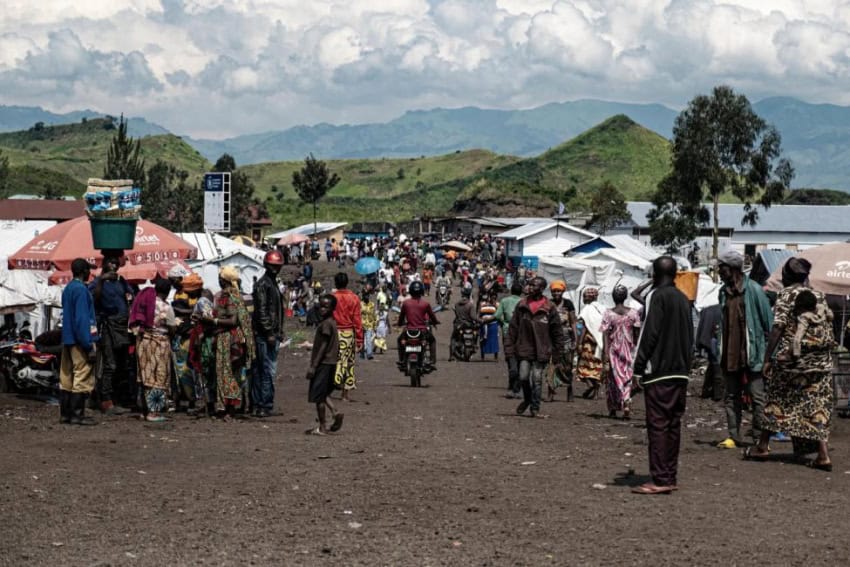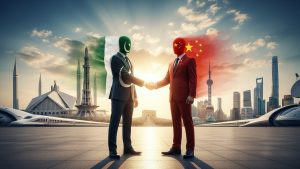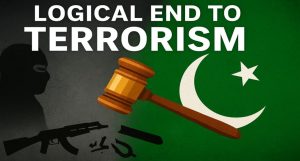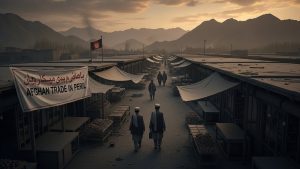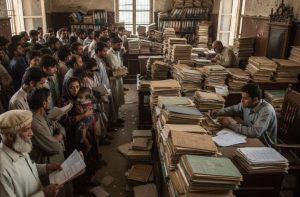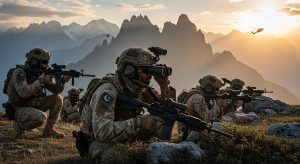“The titanic companies that sell products containing Congolese cobalt are worth trillions, yet the people who dig their cobalt out of the ground eke out a base existence characterized by extreme poverty and immense suffering. They exist at the edge of human life in an environment that is treated like a toxic dumping ground by foreign mining companies. Millions of trees have been cut, dozens of villages razed, rivers and air polluted, and arable land destroyed. Our lives are powered by a human and environmental catastrophe in the Congo.” – Siddharth Kara
“Cobalt Red”, written by Siddarth Kara, is probably one of the most painful books one may ever come across. It describes the horrible and unbearable conditions in which the children, women and men of the Democratic Republic of Congo. (DRC) are engaged in manually extracting cobalt from the earth, from mines and tunnels, for a pittance. These human beings represent slave labor in the twenty first century in a literally toxic environment. Unknown to the world, their children die young without ever going to school and without ever experiencing childhood. The world does not care or mourn for these innocent lives.
Cobalt is needed for rechargeable lithium batteries that power our mobiles, laptops, tablets, and electric vehicles. Joseph Conrad’s novel The Heart of Darkness is said to have been inspired by the pain and suffering of Congo. He described the Congo as “the vilest scramble for loot that ever disfigured the history of human conscience.” In his novel, he summed up the state of affairs in the Congo in the following words: “The horror! The horror”! When Conrad wrote his novel, Congo was in the grip of a merciless tyrant named King Leopold II of Belgium. From 1885-1908 he literally owned DRC. The country was then named Congo Free State – it was a joke of a name because it was literally a slave state. Leopold’s tyranny and unspeakable brutality resulted in deaths of around 13 million people, half of the Congolese population at the time. And yet he has never been held to account properly and condemned in the court of history, either by the Belgians, or by anyone else. Leopold’s blighted and accursed shadow haunts and continues to cause immense suffering to the people of Congo more than a century later.
Joceleyne Corniellle writes: “Leopold appointed certain people who were widely known to use gruesome methods and sadistic punishments. For example, René de Permentier, an officer in the Force Publique, was guilty of torturing and executing natives in his employment for the smallest mistake, and even of massacring entire villages.” Since he happened to generate the greatest amount of rubber in the entire Congo Free State King Leopold probably decided to turn a blind eye to these cruelties as long as the profits flowed. Corniele adds: “In addition, Leopold’s system unhinged the entire Congolese economy because the natives had to spend all their time collecting rubber in order to achieve their quotas, leaving the entire population weakened and malnourished. This, in turn, caused a pandemic of sleeping sickness, which killed up to 60 and even 90% of some population centers.”
Conrad wrote: “It is an extraordinary thing that the conscience of Europe which seventy years ago had put down the slave trade on humanitarian grounds tolerates the Congo Stete today. It is as if the moral clock has been put back many hours. . . . It appears to me that the black man . . . is deserving as much humanitarian regard as any animal since he has nerves, feels pain and can be made physically miserable. But as a matter of fact his happiness and misery are much more complex than the misery or happiness of animals and deserving greater regard. He shares with us the consciousness of the universe in which we live – no small burden. Barbarism per se is no crime deserving of a heavy visitation; and the Belgians are worse than the seven plagues of Egypt insomuch that in that case it was a punishment sent for a definite transgression; but in this the [black] man is not aware of any transgression, and therefore can see no end to the infliction. It must appear to him very awful and mysterious; and I confess that it appears so to me too.”
Congo has been blessed with immense natural resources. It attracted the greedy and ruthless Western powers by virtue of its mineral wealth not too long after it was discovered. And the scramble for its wealth has led to continuing and unending bloodshed and pain for the people of the country. But this pain and suffering, despite its immensity, has been kept hidden from the eyes of the world. Congo’s sufferings have remained in the dark. The Katanga region holds reserves of cobalt that are greater than the cobalt reserves of the rest of the world. It is also known for having reserves of copper, zinc, iron, nickel, manganese, uranium, tin, germanium, tantalum, tungsten, gold, silver and lithium. Its rubber, ivory, palm oil, timber, and diamonds have been plundered over the decades by foreign powers, particularly by Belgium and later the U.S. Very recently the Chinese have begun exploiting the resources in the same manner as their Western predecessors. During the world wars, Congolese copper was used for allied bullets. The poor people of the Congo have been enslaved for centuries now.
The inhuman manual mining by the children, women and men of DRC and elsewhere is described by a term that hides the hideousness of the entire enterprise. It is known as ASM – artisanal and small scale mining. As Siddharth Kara puts it: “Do not be fooled by the word artisanal into thinking that ASM involves pleasant mining activities conducted by skilled artisans. Artisanal miners use rudimentary tools and work in hazardous conditions to extract dozens of minerals and precious stones in more than eighty countries across the global south.” These workers have no cover for injuries, illness, or death and get a paltry return for whatever they manage to dig. They are not assured of regular wages.
Mining of cobalt is hazardous and involves a great deal of toxicity. “The most advanced consumer electronic devices and electric vehicles in the world today rely on a substance that is excavated by blistered hands of peasants using picks, shovels and rebar. Labor is valued by the penny, life hardly at all.” Mining accidents in which children and men are killed go unreported in the media. In many cases the dead remain buried under the rubble and the bodies are not recovered. Armed guards prevent the relatives and acquaintances from digging and finding the dead many a time. Only the relatives and acquaintances of the dead mourn them and the world is utterly unaware of frequent tragedies that afflict these unfortunate people.
In 1990, when the laptops, cell phones and tablets had not yet been introduced, the United States had a deeper interest in cobalt. Cobalt is needed for powerful jet engine aircraft. And the U.S. had only half the stockpiles of cobalt needed during war. Instead of the needed 85 million tons it had only 40 million tons of not so pure cobalt. That generated a strategic interest of the U.S. in Congo’s pure cobalt. The U.S. instigated ethnic massacres in which literally millions of Congolese children, women and men were killed. The U.S. marines were present in Hutu refugee camps from where the insurrection began. In the words of Professor Michel Chossudovsky: “The civil war in Rwanda and the ethnic massacres were an integral part of U.S. foreign policy, carefully staged in accordance with precise strategic and economic objectives.” The civil war began in 1990 and the massacres took place in 1994. A UN report leaked in 2010 revealed that the number of Congolese children, women and men was around six million! These massacres were carried out by Rwandan and Ugandan troops with both countries being run by U.S. client rulers.
A UN report leaked in 2010 threatened to expose the U.S. role in these massacres. Glen Ford wrote: “The 545-page report details crimes committed in Congo by the Rwandan military and its allies between March, 1993, and June, 2003, and reinforces long-standing charges that Kagame’s forces were also aggressors and mass murderers during the Rwandan mass killings of 1994. When Kagame’s Tutsi rebels – previously based in Uganda – gained control of Rwanda after 100 days of fighting and ethnic cleansing, they pursued more than a million Hutu refugees into neighboring Congo. There, they hunted down and killed untold thousands of old men, women and children in 600 documented incidents that are, at the least, war crimes and crimes against humanity. The report’s authors clearly believe the Tutsis engaged in outright genocide – the purposeful eradication of a people – since Kagame’s men made no distinction between Rwandan Hutu refugees and Congolese Hutus; they killed them all. Congolese Tutsis and kinsmen from Burundi joined Kagame’s Rwandan Tutsis in the mass murder – confirming the racial or ethnic nature of the slaughter.” Kagame is a U.S. asset, being a graduate of the U.S. Army Command and General Staff College in Fort Leavenworth. The suffering of the people of DRC is endless.
The reason for the unending misery of the people of Congo owes it to the fact that the demands for new materials that come with new inventions are always met with in DRC. And this has been the case for almost a century and a half. Siddharth Kara points out: “No one knew at the outset that the Congo would prove home to some of the largest supplies of almost every resource the world desired, often at the time of new inventions or industrial developments – ivory for piano keys, crucifixes, false teeth and carvings (1880s), rubber for car and bicycle tires (1890s), palm oil for soap (1900s+), copper, tin, zinc, silver, and nickel for industrialization (1910+), diamonds and gold for riches (always), uranium for nuclear bombs (1945), tantalum and tungsten for microprocessors (2000s+), and cobalt for rechargeable batteries (2012+).” Kara has not properly mentioned the bloody U.S. involvement in the ethinc massacres in the DRC and adjoining regions resulting from the demand for cobalt for jet engines.
An American geologist John R. Farrell was hired by King Leopold II to carry out detailed assessment of the copper reserves in the Katanga copper region. In 1902 Farrell wrote to the King: “It will be utterly impossible to exhaust your bodies of oxidized ores during the century . . . The quantity of copper you can thus produce is entirely a question of demand – the mines can supply any amount.” Indeed, during WWII, the Katanga copper mines produced eight hundred thousand tons of copper for the manufacture of Allied ordnance. In addition the region provided gold, tungsten, tin and cobalt for the Allied war needs.
What makes the extraction of cobalt toxic? Heavy metals contaminate the air, water and food supply. Studies conducted by researchers establish that artisanal miners have “more than forty times the amount of cobalt in their urine as the control groups. They also have five times the level of lead and four times the level of uranium.” Researchers have also found out that those living close to the mining areas but who are not artisanal miners have “very high concentrations of trace metals in their systems, including cobalt, copper, zinc, lead, cadmium, germanium, nickel, vanadium, chromium and uranium.” Such toxicity shortens the lives of artisanal miners and affects children in particular more adversely. A researcher told Kara: “Even if children do not work in mines, indirect exposure to heavy metals from their parents is worse for them than direct exposure for the adults. This is because a child’s body cannot remove heavy metals as well as adults can.”
The largest mining area for cobalt is in the Lualaba province, which is located in the extreme southwestern region of DRC. TFM (TenkeFungurume, Tenke and Fungurume are two towns) and Mutanda are the two biggest mines located in this province. TFM covers about 1,500 square kilometers. Thousands of villagers residing here were evicted in 2006 when a joint venture between a U.S. mining company Phelpp Dodge, Tenke Mining Company and Gecamines was begun. In 2007 Phlepp Dodge merged with Freeport-McMoran (56%), Tenke Mining was acquired by Lundin Mining (24%), leaving 20% share for Gecamines. In 2016 Freeport sold its share in TFM to CMOC (China Moledydnum Co) and thus the U.S. presence in Congo’s cobalt mining ended. Freeport was forced to sell its share on account of bad investments in the oil and gas sector elsewhere.
The road connecting towns of Likasi and Kolwezi in Lualaba province carries the heaviest cobalt laden traffic. Siddarth Kara describes the impact of mining and the traffic on the area. “The heavy traffic and perpetual mining activity west of Likasi has resulted in dangerous amounts of air pollution. A thick cloud of fumes, grit and ash suffocates the land. Sky and earth meet vaguely above the hills at some obscure and unattainable frontier. Villages along the road are covered with airborne debris. Children scamper between huts like balls of dust. There are no flowers to be found. No birds in the sky. No placid streams. No pleasant breezes. The ornaments of nature are gone. Only the fragments of life remain.”
Those who had resided in the region for long but were kicked out of their ancestral homes are bitter. In the words of a resident of Fungurume: “We lived on the land for three generations before the mining companies came. We grew vegetables and caught fish. They threw us out and now we cannot find enough food to feed our families . . . . We have no jobs in this area. How do they expect us to live?” Residents were kicked out in 2006 with little or no compensation. One of the translators told Kara: “Imagine if a mining company came to the place where you lived and they kick you out. They destroy all your belongings except whatever you can carry in your own hands. Then they build a mine because there are minerals in the ground, and they keep you out with soldiers. What can you do if there is no one to help you? Maybe you would feel it is your right to go back to that place where you lived and dig some of the minerals for yourself. This is how the people in Fungurume feel.” No wonder sometimes violence breaks out. When CMOC security forces could not cope, the army had to be called out.
In 1960, when DRC gained freedom from Belgium, there was hope and possibility of better life for the Congolese. Patrice Lumumba was a popular and populist elected PM of the country. But the colonial power Belgium and the Anglo-American agencies conspired to destroy this hope and to deny the people of DRC the right to live with dignity. The then Belgian King Baudouin declared that the independence of Congo was “the culmination of the work conceived by the genius of King Leopold II . . .” Leopold II had ruled the country ruthlessly and with the utmost brutality and the people of Congo, and indeed of all Africa, had not forgotten that. In an impromptu response full of justified anger, Lumumba declared that millions of Africans had been “enslaved” by Leopold II. He condemned the “humiliating slavery” imposed by the Belgians on the people of Congo who, he declared, would never forget the “grueling labor, demanded from us in return for wages that did not allow us to satisfy our hunger . . . or to raise our children as creatures very dear to us.” He pointed out that the raw materials of the Congolese were “stolen” under “cruel and inhuman” laws. He ended his speech by saying to the Belgians: “We are no longer your monkeys.”
A mere eleven days after independence the Belgians backed Moise Tshombe to declare Katanga, the source of the mineral wealth the country, independent! This move crippled DRC by denying it the real source of its wealth. Lumumba wrote the UN for help. The UN Secretary General at the time was an idealist Swede named Dag Hammarskjold. On August 9, 1960, the diamond rich province of South Kasai declared independence under a nominal leader named Albert Kalonji. This further deepened the crisis. Both secessions were prompted by the Belgians which also had about 7,000 troops in the country. The UN launched the largest operation in its history to keep DRC intact. It demanded the withdrawal of Belgian troops from the country and decided to police the DRC using 15,000 UN troops from eighteen countries which had no interest in the Congo. Lumumba, however, seems to have lost hope in the ability of the UN to keep DRC intact, and, on August 15, 1960, appealed to the Soviet Union for help.
Nicholas Langer writes in the Undergraduate Historical Journal of UC:: “The position of Belgian security forces in the Congo further refutes any allegation of Lumumba holding communist sympathies or of a Soviet threat existing in the Congo. Such a position comes from Colonel Vanderwalle, who was head of the Belgian Colonial Intelligence Service during the Congo Crisis, for he ‘openly [dismissed]…even the existence of a ‘Soviet threat’ in the Congo at the time.’ This situation, then, would seem to fly in the face of any stated American foreign policy position. Lumumba did not represent an apparent communist or Soviet threat . . . “
The orthodox line in the matter is that the possibility of Soviet involvement in DRC immediately activated the American and British establishments. CIA Director Allen Dulles, one of the most evil men of the 20th century, wrote to Larry Devlin, the CIA station chief in Leopoldville (now Kinshasa), that “removal [of Lumumba] must be an urgent and prime objective . . . this should be a high priority of our covert action.” On September 5, 1960, as a result of the machinations of the CIA and MI6, President Kasavubu dismissed Lumumba and six other ministers of the elected government. This action of the president was condemned in a joint meeting of the upper and lower houses of the Parliament. But the CIA was unrelenting in its determination to eliminate Lumumba. Under direction of the CIA the president dissolved the parliament on September 14 and a 29 year old CIA asset named Col. Desire Mobuto took over control of the country. That ended DRC’s still born democracy with the full involvement of the CIA, MI6 and the Belgians.
Since JFK was to be sworn in on January 20, 1961, and since his sympathies for pan-African leaders were known, the CIA hastened to have Lumumba killed on January 16, 1961. Lumumba was tortured by six Belgians and six Katangans, including Moise Tshombe and his second in command, Goderoid Munongo, before being shot dead. His body was chopped up and body parts thrown in sulfuric acid. As if that was not enough, his skull and teeth were ground and scattered on the return drive from the murder place. Only one tooth was kept as souvenir for the Belgian commissioner of the police in Katanga. The brutality of this assassination must have pleased and delighted Allen Dulles who was, in a couple of years, to play a role in the JFK assassination. The world knew immediately that Lumumba’s brutal assassination was a CIA plot and there was global outcry against it. The news of Lumumba’s assassination was kept from the newly elected President JFK, who was “horror stricken”, when, on February 13, 1961, he found out that Lumumba had been killed.
In February 1961, Mobutu returned government control back to Kasavubu, who, in turn, appointed Mobutu army chief. In 1965 Mobutu staged a coup and assumed power. Mobutu ruled the country from 1965-1997, renaming it Zaire in 1971. Mobutu was a thoroughly corrupt dictator who stayed in power for 32 years with U.S. help and support. He enjoyed the support of presidents Nixon, Bush, Reagan and Clinton because he assumed an anti-communist posture. “He siphoned billions of dollars from the country’s mineral exports into personal bank accounts, becoming one of the ten richest people in the world during the 1980s.” He owned a fleet of Mercedes vehicles on which he commuted between various palaces and places on dilapidated roads. For his shopping trips to Paris he would hire a Concorde plane of Air France. To allow the landing and takeoff of a Concorde he had a special airport with extended runway built.
With collapse of the Soviet Union Mobutu’s value for the U.S. also diminished. The U.S. had prepared other players like Paul Kagame of Rwanda. Using a Katangan front man Laurent Desire Kabila, and in combination with Uganda, Kagame orchestrated an attack on Katanga. It was while Mobutu was in power that the massacre of Hutus was started by the Rwandans. This could happen because Mobutu had made his country weak. This massacre led to his downfall and a rebellion, supported by neighboring countries such as Rwanda, Uganda, and Burundi, and spearheaded by Laurent-Desire Kabila, resulted in his overthrow in 1997, when Kabila assumed power. Mobutu fled the country and died the same year as he was suffering from cancer.
Kabila was no different from Mobutu. He made deals with foreign mining companies and stole the nation’s money. Kabila made a basic mistake – in July 1998 he ordered the Rwandan and Ugandan forces to leave the country. These forces had brought him to power. U.S. proxy Paul Kagame orchestrated a rebellion against Kabila in August 1998. Kara writes: “What followed on August 2, 1998, and for years thereafter became known as ‘Africa’s Great War’ involving nine African nations and thirty militias and that laid waste to the DRC and resulted in the deaths of at least five million Congolese civilians.” Troops from Zimbabwe, Sudan, Namibia, Angola, Chad, Rwanda, Uganda and Burundi were involved in the plunder and destruction of DRC. U.S. intelligence officer, Col. L. Fletcher Prouty, who had a desk in White House from 1954-1963 wrote about the views of Malthus, who was the head of the economics department of Haileybury College, which was established by the East India Company. He writes: “The Malthusian theory thus provides a rationalization for the necessity of somehow getting rid of large numbers of people, any people, in anyway – even genocide. With the Malthusian theory as the power elite’s philosophical guide, this became an acceptable objective, because, they believe, Earth will never be able to support the progeny of so many anyhow. From this point of view, genocide – then as now – is accepted as all but inevitable. Who cares and why be concerned?” The poor people of DRC are victims of a Malthusian Western elite that is pillaging and plundering their land for a century and half, and killing them off at the same time. And no one seems to care.
Laurent-Desire Kabila is, according to one version, said to have been murdered by one of his guards on January 16, 2001. On January 26, 2001, his son Joseph Kabila was inaugurated as the President of DRC. Joseph Kabila signed an agreement on December 17, 2002, which required withdrawal of Ugandan and Rwandan troops from DRC but created spheres of control which allowed Rwanda and Uganda to exploit minerals in certain regions of DRC. Rwanda got control of coltan trade in Kivus while Uganda took control of gold trade apart from getting involved against Rwanda in a bitter fight for control of the diamond trade. DRC was being plundered by its neighbors who had backing of Western powers, particularly the U.S. and its erstwhile ally, the U.K. Joseph Kabila entered into mining deals with Chinese companies in 2009 “in exchange for kickbacks funneled through his accounts at BIGIBank.” Kabila’s second term as president ended in 2016 but he delayed elections till 2018 when his handpicked successor Felix Tshisekedi was elected in a questionable election.
Once Tshisekedi was sworn in (January 2019) the U.S. ambassador to DRC Mike Hammer met him and talked about U.S. concern for human rights. He assured ambassador Hammer that he was “committed to human rights.” The U.S. concern for human rights is hypocritical and utterly fraudulent – the U.S. agencies were behind the massacre of 5-6 million Congolese civilians. A Western diplomat told Siddharth Kara “off the record” that “President Tshisekedi does not want to continue the practice of complete Chinese exploitation of his country, whereas Kabila and his cronies depend on the Chinese because it filled their pockets.” In November 2021 a judicial investigation against Kabila and his accomplices, for alleged embezzlements to the tune of $138 million, was initiated.
Siddharth Kara opens and closes his book by narrating an accident that he witnessed in the mining area of Kamilombe. “I move closer to investigate, treading carefully into the boiling crowd. I catch sight of a body in the dirt. It is a child, lying motionless within a storm of dust and despair. I try to make out the features of his face, but they elude me. Around the lifeless body, the ocher gravel has been stained in dark shades of red, like burnt umber or rusted metal. Until this moment, I thought that the ground in Congo took its vermillion hue from the copper in the dirt, but now I cannot help but wonder whether the earth here is red because of all the blood that has spilled upon it.” However, as Col. Prouty wrote: “Who cares and why be concerned?”

